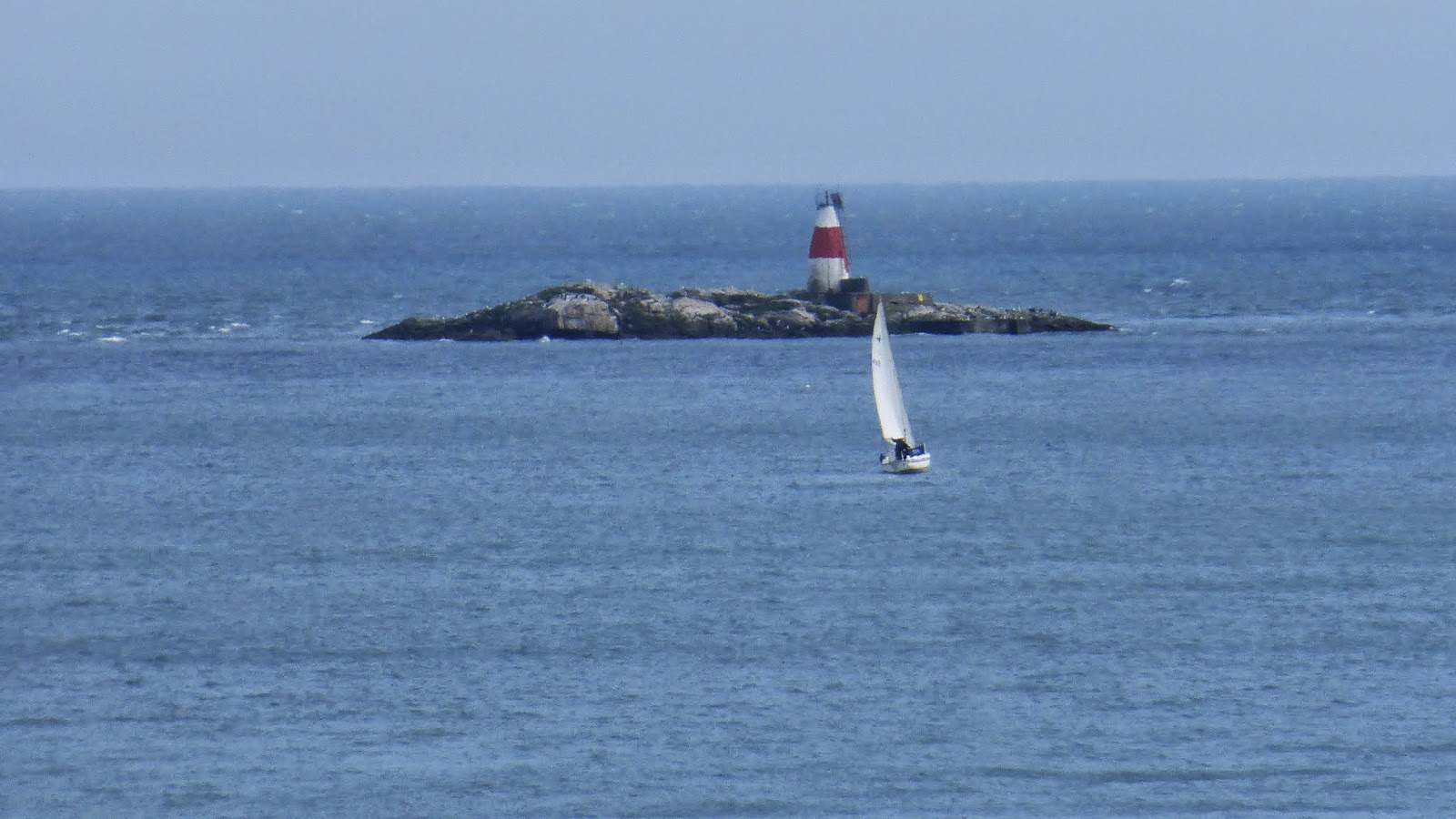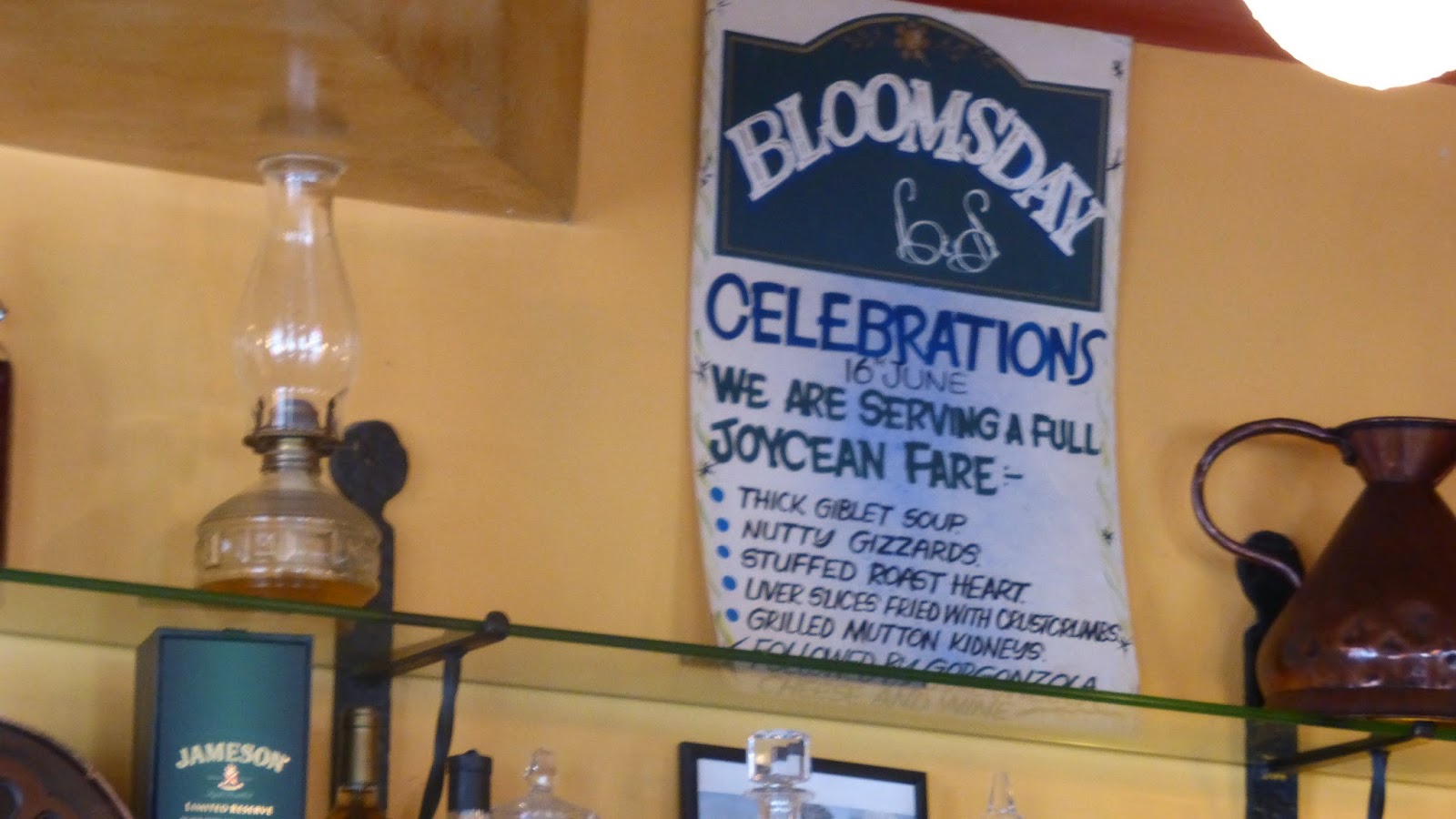 |
| Bus into Dublin from Churchtown |
 |
| Colorful Dublin doorways |
Here less than two full days and it already feels like a week. Having my fill already of pubs and music last night I wasn't sure what could match up. Waking bright and early, we had Irish pork sausage and oatmeal for breakfast.
Then we caught the bus into town to St Stephen's Green for a reading of
James Joyce's Ulysses at
Sweny's Pharmacy.
 |
| St. Steven's Green, one of Joyce's haunts. |
First we stopped at the Bank of Ireland to buy euros and then passed byThe Shelburne, the oldest, grandest hotel in Dublin.
 |
| The Shelburne Hotel |
We stopped in to see where the "better half" vacation and to ogle at the chandeliers and flowers.
 |
| A menu for the visit of Queen Elizabeth |
Then over to Sweny's by 11 for the regular Sat morning reading. Sweny's is the actual apothecary, which Joyce used to patronize and which he used as the basis for Leopold's Bloom's purchase of lemon soap and Molly's prescriptions. They had the actual bars for sale at 5 euro.
 |
| Leopold Bloom's Lemon Soap |
The reading was introduced and lead by Rodney Devitt, a Joycean scholar and resident of Sandymount, the old village near where the novel begins. He has written a delightful guided tour of his village following in the footsteps of Joyce called Walking Into Eternity. Rodney and his wife handed out copies of the book and cups of tea. A plate of Turkish delight was passed around as well.
 |
| Rodney Devitt chats with Janet - Sweny's Apothecary 1 Lincoln Place, Merrion Square, Dublin |
 |
| Lemon Soap for Sale |
 |
| An original sketch of Joyce |
The apothecary was small and narrow with wood and glass counters behind which were shelves for the medicines and other chemicals that a druggist would need to fill prescriptions. Some old bottles remained, but the shelves are mostly lines with books as that's what the old store is used for now. We all took seats on cushioned benches behind the counters. The few stragglers who came in late had to sit in the middle. Starting on page 213 we all took turns reading a page. Anyone who has read Ulysses knows that it is modeled on Homer's Odyssey and follows one day in lives of several Dubliners - June 16th, 1904 - or Bloomsday as it has become known. We read a section where Joyce does a kind of survey of the characters in the book at midday. The section ends with a cavalcade of horses and coaches as the British Lieutenant (pronounced "Leff-tenant") parades through the streets of Dublin and is generally ignored by all, but small children.
 |
| Reading passages from Ulysses |
Joyce's language spoken with the rich Irish accents of the local readers was lovely to hear. Those of us who were Americans in the group, tripped over the cadence and the squished together words, completely lacking in punctuation, that is so typical, yet brilliant of Joyce. I myself had to handle several passages in Latin! A minor horror show.
Lively conversation followed. Some very specific directions from Rodney on how to retrace Stephen Dedalus' steps from Sandy Cove to Dublin by taking the DART train down to the village of Sandymount where the Martello Tower still stands.
For those interested in Sweny's there is talk of shutting the store and tearing it down. To learn more about efforts to save it visit: http://www.change.org/en-GB/petitions/friends-of-sweny-s-pharmacy-save-sweny-s-pharmacy-from-closure?utm_source=share_petition&utm_medium=facebook&utm_campaign=share_facebook_mobile&recruiter=28702558
 |
| The Martello Tower in Sandycove where James Joyce sets the beginning of Ulysses |
 |
| Tourists enjoying the view from the Tower |
 |
| Janet negotiating the narrow staircase |
 |
| The Martello Tower - James Joyce Museum |
The actual tower room where Joyce stayed briefly with roommates (upon which he based his characters: Mulligan, Heath and Stephen Dedalus-representing himself) is still intact with beds, a hammock and a table set for breakfast. The sea and islands he describes from the tower are all in the distance and the beach upon which Stephan Dedalus strode "into eternity," stretches to the north. We are unusually lucky as it is a crystal clear day with light blue skies - not at all characteristic for Ireland.
 |
| The bedroom with table set for breakfast |
 |
| Village of Sandymount from the tower |
 |
| The small island mentioned by Stephen Dedalus in the beginning of Ulysses |
"Stephen's boots crush crackling wrack and razor shells, squeaking pebbles, wood sieved by the sandworm, lost Armada. Open your eyes, a stride at a time. Am I walking to eternity along Sandymount Strand?"
 |
| A sketch of the tower |
The walk from the train station at Dun Laoghaire, down the boardwalk and beach toward Sandy Cove and the tower, was particularly moving to me, because I read Portrait of the Artist as a Young Man, and its rough draft simply titled Stephen Dedalus, as an impressionable teenager in high school. I remember being heavily influenced by Joyce's creative use of language and stream of consciousness, just like every other writer in the modern/post-modern era. And too I remember being a typical brooding adolescent and very identified with this protagonist. This is certainly a privilege, as I never dreamed of being able to walk is if in his shoes.
From the museum we walk back through the village of Sandymount, filled with lovely stone houses and gardens.
 |
| A magpie |
Then we land in a pub which regularly holds a Bloom-fest on June 16 to celebrate the original in 1904. Its windows have stained glass panels illustrating the sections of the famous book.
 |
| Stained glass panels representing the different sections of the book Ulysses. |
 |
| Wall painting quoting from Ulysses |
 |
| An announcement for a Bloomsday Celebration at the Sandymount pub |
DART Train home to Connelly Station and the #14 bus to Churchtown. Steve cooked dinner and we watched Law & Order on TV as we were exhausted from our adventures. I have begun reading Irish history and legends. Its a mixture of myth, magic, Christian and pagan lore, Celtic, Gaelic, Norman, Norse, Roman and English influences. Not simple. There is a strong pagan mystery behind the arts and literature. The Filli were oral storytellers - the early bards - during the time of the Druid priests. The ancient tales were passed along simply through song, ballad and poems long after other cultures on the European continent employed written language. As a result Ireland to this day retains its strong oral storytelling culture and is famous for its bards.
Tomorrow The Book of Kells at Trinity College and perhaps the National Museum for some archeological history.
Monday Newgrange and the ancient tombs at Bru na Boinne.
























